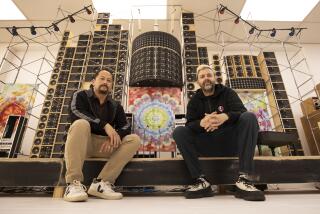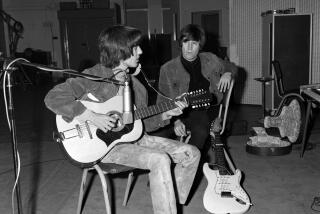Strings Attached to Music History : Tribute: Curator of Fender exhibit in Fullerton traces innovations of the late Orange County guitar maker.
FULLERTON — “Brother musician, listen to a miracle!”
So declared the cover of one 1930s musical instrument catalogue featured in electric guitar historian Richard Smith’s lecture--aptly enough, on the history of the electric guitar--Saturday at the Fullerton Museum Center.
As miracles go, the big twang of the electric guitar might not seem as immediately impressive as walking on water, but the stringed things have certainly had a pervasive effect on the culture of this old world. That is a notion implicit, though not oppressively so, in the museum’s “Five Decades of Fender: The Sound Heard Around the World” exhibit, celebrating the creations of Fullerton’s Henry Ford of the electric guitar, the late Leo Fender.
Smith curated the exhibit, and it clearly is a work of love. He has amassed more old, rare Fender instruments than have ever been under one roof, including such primordial guitars as the original 1940s prototype for the Fender Esquire, which, re-dubbed as the Telecaster, revolutionized the music world as the first successful mass-produced solid-body guitar.
Though an ungainly plank of wood, it is the sort of thing that produces rapture in guitar players and collectors. Fortunately for others, the exhibit also allows a broader appreciation of Fender’s works, showing how they sprang from a peculiarly Southern Californian sense of style and invention, and how they went on to influence music around the world. Though the exhibit, which opened Dec. 10, doesn’t complete its run until April 2, it has already become the most well-attended exhibit in the museum’s history.
Fullerton resident Smith was formerly a columnist for Guitar Player magazine and has authored a respected book on Rickenbacker guitars, as well as a long-anticipated tome on Fender expected out late this year. He was a friend of Fender, who died in 1991, as well as one of a long line of working musicians who Fender turned to in perfecting his instruments.
Though expert in the screw sizes, magnet composition and other minutiae in which guitar collectors revel, Smith also can make his subject compelling to a more general audience. He has previously made keen observations on the social effects of the electric guitar, such as its role in bringing to global prominence the “working man’s” styles of American country, blues, R&B; and rock music.
Not much of that insight went into his presentation Saturday, which was more of a straight-forward citing of the events and persons that led to the development of the modern electric guitar. It was not so much a lecture as it was a heavily annotated slide show, and, as a result, was neither as lucid nor linear as it might have been.
Rather than use a few slides to illustrate points he was making in his speech, the presentation was instead slide-driven, with Smith’s narrative sometimes falling by the wayside as he tried to keep pace with the parade of faces and stringed instruments projected behind him. Given that, as well as having to introduce terminology like vibrato bar and truss rod to guitar novices, and the polite but unnecessary constraint of trying to keep his program brief, Smith did cover a lot of ground.
While taking nothing away from Fender’s genius, Smith made it clear that his pioneering innovations didn’t take place in a vacuum, but, rather, were the culmination of a long line of oddball California creativity.
According to him, that line started in the 1920s with the invention in Los Angeles of National guitars, which, instead of wood, relied on resonator cones of spun aluminum for their volume. Next came the invention of the first electric guitar pickup--a Rube Goldberg-looking thing with huge horseshoe magnets--by Rickenbacker in the 1930s. It also was a West Coast innovation, where designers weren’t tied to wood craftsmanship of the East Coast companies tied to European traditions. Rickenbacker, for example, had also manufactured toothbrush handles of the then-new plastic Bakelite, and couldn’t see any reason not to make his guitars of the same stuff.
These infidel innovations were first employed on the slide guitars used in the Hawaiian music that was popular early in the century. Smith explained that those instruments found their way into other styles of music, such as country and Western, after Hawaiian musicians had toured the States in tent shows.
Though racing over a lot of material, Smith’s delivery wasn’t dry. With one photo, where an electric slide player was seated amid several acoustic instrument players in front of a tacky Hawaiian-themed backdrop, he explained, “You might be wondering why he needed an electric instrument. It’s so he could be heard over the volcano you see there.”
The photographs, catalogues and other source material Smith collected for his slides often gave a sense for the weird spirit of their times. One from the 1930s showed Bert Lynn and His All Electric Orchestra, with futuristic Rickenbacker electric violins, bass fiddles and other odd instruments presided over by director Lynn’s Buck Rogers-looking control panel.
He also presented catalogue pages suggesting that parents buy their kids instruments because they “solve individual problems” and “promote a feeling of importance.”
The later slides and recollections of Fender’s early days--his first shop was on Harbor Boulevard, just a few blocks from the museum--were evocative of a more innocent Orange County, when Fender would roll his public address system around on a trailer to local events, and his partner Doc Kauffman would play electric guitar in a local supermarket, announcing store specials between songs.
In the anti-tradition of the California guitar makers before him, Fender had “a vision of what a guitar should sound like, instead of the way it had, “ Smith said. The result was the Telecaster, which had a treble-laden presence musicians came to call “that take-off tone” for the way it would blast out of any musical setting.
After the presentation, Smith said if he’d had more time he would have included a number of examples of the “unintended consequences” of Fender’s inventions, such as the way the sturdy instruments come in handy in a bar fight.
As it was, he only included one “unintended consequence” slide, which said loads. It was a photo featuring several instruments made by Fender--who was a lifelong country music fan--in the hands of wild rockers Gene Vincent and the Bluecaps.
More to Read
The biggest entertainment stories
Get our big stories about Hollywood, film, television, music, arts, culture and more right in your inbox as soon as they publish.
You may occasionally receive promotional content from the Los Angeles Times.










